Birds with red heads are an intriguing gathering of avian species that catch the consideration of birdwatchers and nature fans all over the planet. Their energetic plumage and exceptional behaviors make them stand out in the avian world. In this article, we will dive into the existence of these spellbinding animals, investigating their attributes, habitats, and importance.
Exploring Different Types Of Birds with Red Heads
1. Red-Headed Woodpecker
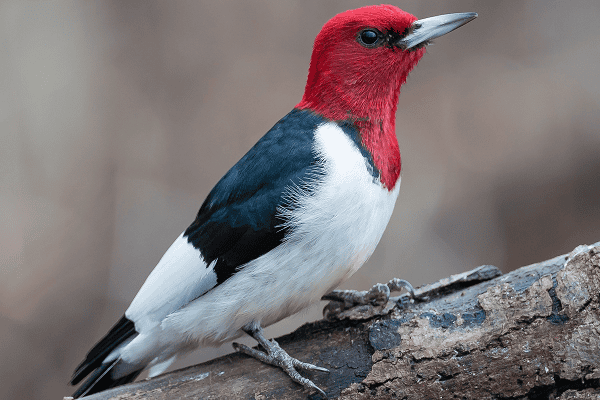
The Red-Headed Woodpecker (Melanerpes erythrocephalus) is a striking bird tracked down in North America. Known for its unmistakable red head and highly contrasting body, this woodpecker is much of the time seen in lush regions, open woodlands, and parks. An eating routine comprising of bugs, natural products, and seeds, it assumes an essential part in keeping up with biological system balance by controlling bug populaces.
Habitat and Behavior
Red-headed woodpeckers are gifted tumblers, frequently seen gripping to tree trunks and branches as they look for bugs stowing away underneath bark. They are likewise known for their propensity for putting away food, like oak seeds, in tree cleft. This behavior assists them with making due during unforgiving winters when food is scant.
Fascinating Truth
Did you have at least some idea that the Red-Headed Woodpecker’s striking appearance fills in as an advance notice to predators? The radiant red head flags that the bird might be unpalatable or even harmful, deterring likely dangers from drawing closer.
2. Scarlet Tanager
The Red Tanager (Piranga olivacea) is a transient warbler tracked down in the eastern pieces of North America. While the male games a lively red plumage, the female is olive-yellow. These birds favor mature woods, making their homes in high shelters.

Breeding Habits
During breeding season, male Red Tanagers utilize their striking red plumes to draw in females. Their homes are carefully woven and tucked away among leaves to shield the eggs from predators.
Protection Status
Red Tanagers face habitat misfortune because of deforestation, putting forth protection attempts essential to their endurance. Supporting woods conservation drives can assist with safeguarding these delightful birds.
3. Northern Cardinal
The Northern Cardinal (cardinalis) is the dearest bird known for its clear red plumage and unmistakable peak. Local to North America, this bird’s happy tune and lively appearance make it number one among birdwatchers.
Imagery and Social Importance
The Northern Cardinal holds social importance in a few districts. In certain societies, its appearance is related with messages from friends and family who have died. Furthermore, its red plumes are frequently connected to imperativeness and enthusiasm.

Flexibility
One surprising component of the Northern Cardinal is its versatility to different conditions, including metropolitan regions. Their eating routine comprises of seeds, natural products, and bugs, making terrace feeders a typical spot to recognize these birds.
Visit: The Top 10 Largest Birds of Prey
4. Vermilion Flycatcher
The Vermilion Flycatcher (Pyrocephalus rubinus) is a little passerine bird tracked down in North and South America. With an energetic red head and striking dark markings, this bird is an incredible sight.
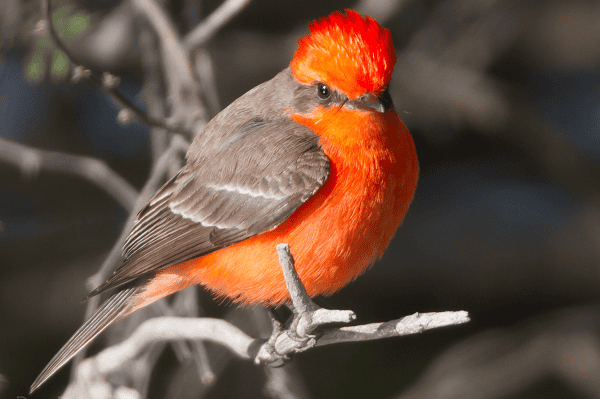
Feeding Behavior
Vermilion Flycatchers are gifted ethereal trackers, getting bugs in mid-flight. They frequently roost on uncovered branches or wires, sitting tight for a potential chance to shoot up high and catch their prey.
Migratory Patterns
A few populaces of Vermilion Flycatchers are transitory, voyaging significant distances between their breeding and wintering grounds. This behavior assists them with finding appropriate food sources consistently.
5. Red-Headed Finch
The Red-Headed Finch (Amadina erythrocephala) is an enchanting finch animal group local to Africa. The male games a dynamic red head, while the female’s head is dark brown.
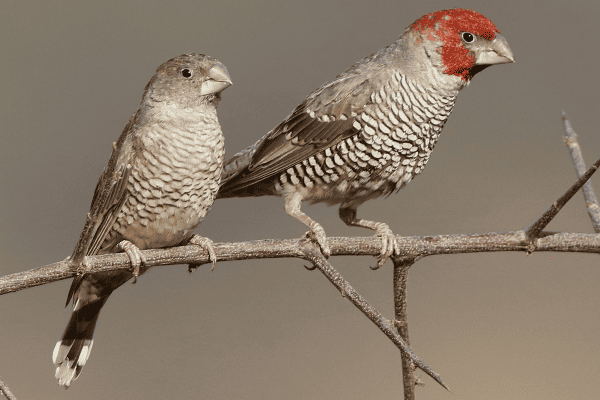
Breeding and Nesting
Male Red-Headed Finches take part in intricate romance presentations to draw in females. When a couple structures, they cooperate to construct complicated homes utilizing twigs, grass, and plumes.
Social Behavior
These finches are profoundly friendly birds, frequently found in herds. Their fun-loving connections and resonant calls add enthusiasm to their habitats.
6. Flame Robin
The Fire Robin (Petroica phoenicea) are little Australian bird with red heads known for its searing red-orange bosom. These birds are much of the time tracked down in open woodlands and lush regions.

Breeding Season
During the breeding season, the Fire Robin’s energetic plumage becomes the dominant focal point as guys sing and show to draw in females. Their homes are underlying all-around secret spots to safeguard their eggs from predators.
Conservation Efforts
Habitat misfortune and environmental change present dangers to Fire Robin populations. Preservation endeavors center around protecting their habitats and bringing issues to light about their significance in the environment.
Related Article: Brown Birds with Red Heads
7. Ruby-Crowned Kinglet
The Ruby-Delegated Kinglet (Regulus calendula) is a minuscule warbler with an unlikely treasure — the ruby-red crown on the male’s head. These birds are tracked down in North America and are known for their high-energy scavenging behavior.

Foraging Techniques
When it comes to birds with red heads then Ruby-delegated kinglets have an amazing scavenging style, continually floating, fluttering, and jumping as they look for bugs and insects tucked away among leaves and branches.
Breeding and Migrations
These birds embrace momentous relocations, going from their breeding grounds in North America to their wintering grounds in Mexico and Focal America.
8. House Finch
The House Finch (Haemorhous mexicanus) is a typical bird tracked down all through North America. Guys show different shades of red on their heads, which can go from radiant red to orange.
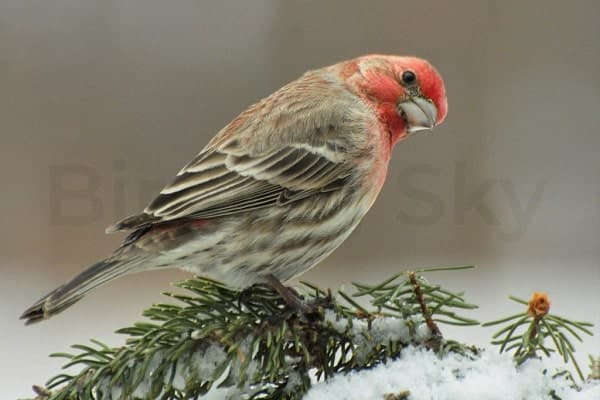
Urban Adaptation
House Finches have effectively adjusted to metropolitan conditions, frequently constructing homes on structures, edges, and in any event, hanging growers. Their capacity to flourish in human-altered landscapes exhibits their strength.
Song Variations
Strangely, House Finch melodies can fluctuate essentially founded on the geological area. These varieties have permitted analysts to concentrate on their vocalizations and their expected job in mate fascination.
9. Red-Headed Amazon Parrot
The Red-Headed Amazon Parrot (Amazona rhodocorytha) is a dynamic parrot animal type tracked down in pieces of Focal and South America. Its striking red head and green body make it a pursued pet and a magnetic bird to detect in nature.

Vocal Abilities
Red-headed Amazon Parrots are known for their noteworthy vocalizations, which incorporate mimicry of different sounds and human discourse. This ability has added to their ubiquity in the pet exchange.
Conservation Challenges
Habitat misfortune and unlawful catching for the pet exchange undermine the endurance of these parrots. Endeavors to safeguard their regular habitats and control the pet exchange are vital for their drawn-out endurance.
10. Crimson Rosella
The Ruby Rosella (Platycercus elegans) is a vivid parrot local to Australia. With a dark red head and dynamic blue and green plumage, this bird adds a sprinkle of variety to its environmental elements.
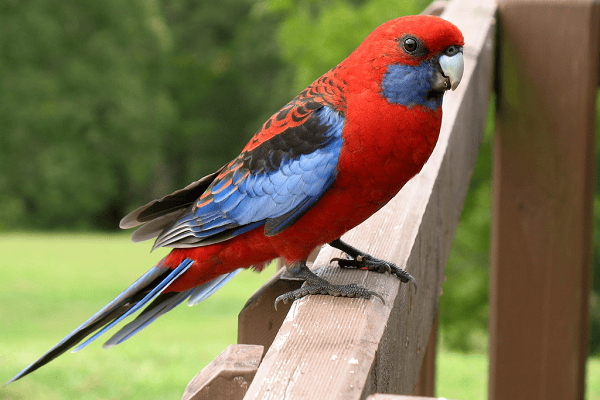
Feeding Habits
Dark red Rosellas have a shifted diet that incorporates seeds, organic products, blossoms, and bugs. Their solid bills permit them to air out seeds and concentrate nectar from blossoms.
Conservation Status
A populaces of Ruby Rosellas are undermined because of habitat obliteration and presented predators. Preservation endeavors center around safeguarding their normal habitats and controlling obtrusive species.
11. Red Headed Blackbird
The Red Headed Blackbird (Amblyramphus holosericeus) is a striking bird tracked down in wetlands of South America. As the name proposes, guys have dark red heads, appearing differently in relation to their dark bodies.

Breeding Behavior
During the breeding season, male Red Headed Blackbirds make complicated woven homes that dangle from reeds. These homes give assurance to their eggs and chicks against possible predators.
Wetland Habitat Significance
Red Headed Blackbirds occupy wetlands, where their taking care of and settling behaviors add to the soundness of these indispensable biological systems.
12. Red-Headed Barbet
The Red-Headed Barbet (Eubucco bourcierii) is a bright bird tracked down in the montane timberlands of Focal and South America. Its particular red head and many-sided markings make it a standout animal type.

Taking care of the Environment
Red-headed barbets feed on foods grown from the ground. They assume a part in seed dispersal, adding to the development and recovery of forested regions.
Vocalizations
These barbets are known for their unmistakable calls, which can shift from resonant whistles to more brutal, chortling sounds.
13. Red-Confronted Cormorant
The Red-Colored Cormorant (Phalacrocorax urile) is a marine bird tracked down along the shores of the northern Pacific Sea. While their bodies are principally dark, their particular red face separates them.

Unique Feeding Behavior
Red-Confronted Cormorants are beautiful birds with red heads. These birds are outstanding jumpers, utilizing their webbed feet to impel themselves submerged looking for fish and other marine animals.
Colony Nesting
These cormorants are social birds, frequently settling in provinces on rough beach front bluffs. Their provinces can comprise of hundreds to thousands of birds, making a hypnotizing exhibition.
You May Also Like: Birds With Long Beaks
14. Northern Flicker
The Northern Flash (Colaptes auratus) is a woodpecker animal groups with a particular appearance. The male’s red-screwed feathers on the underside of its wings are especially attractive.

Unique Woodpecker Traits
Not at all like numerous woodpeckers, Northern Glints frequently search on the ground, utilizing their specific mouth to search for subterranean insects and bugs in the dirt.
Drumming Behavior
These woodpeckers are known for their drumming behavior, which includes utilizing their bills to make musical sounds on surfaces like dead trees or metal articles.
15. Red Bunch
The Red Bunch (Calidris canutus) are transitory shore birds with red heads and throat. These birds embrace amazing significant distance relocations.
Migratory Feats
Red Bunches have one of the longest movements of any bird, going from their Icy breeding grounds to their wintering regions in the southern half of the globe.
Conservation Concerns
Habitat misfortune and aggravation during relocation present difficulties to Red Bunch populaces. Worldwide preservation endeavors plan to safeguard their basic visit sites.
Visit: AMAZING Jungle Birds Of The Rainforest
16. Crimson Sunbird
The Crimson Sunbird (Aethopyga siparaja) is a small passerine bird found in parts of Asia. Its dazzling crimson head and throat feathers make it a standout in its habitat.
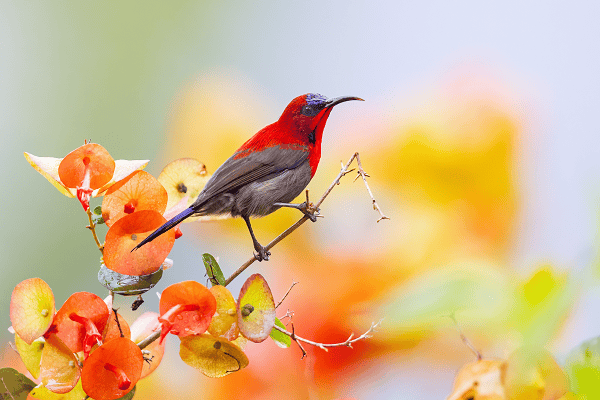
Nectar Feeding
Crimson Sunbirds are specialized nectar feeders, using their slender, curved bills to extract nectar from flowers. This feeding behavior also contributes to pollination.
Display and Courtship
During courtship, male Crimson Sunbirds perform impressive aerial displays, showcasing their vibrant plumage and agility to attract females.
17. Red-Headed Pileated Gibbon
The Red-Headed Pileated Gibbon (Hylobates pileatus) is a primate found in Southeast Asia. Named for the tuft of red fur on its head, this gibbon is known for its distinct calls.
Family Structure
Pileated gibbons live in family groups, consisting of a monogamous pair and their offspring. Their strong social bonds are reinforced through grooming and vocalizations.
Vocal Communication
Gibbons, including the Red-Headed Pileated Gibbon, are renowned for their intricate vocalizations, which help establish territory boundaries and communicate with other gibbons.
18. Vermilion Cardinal
The Vermilion Cardinal (Cardinalis phoeniceus) is a bird endemic to Colombia and Venezuela. Its stunning red plumage and melodic song make it a sought-after sight for birdwatchers.

Range and Habitat
Vermilion Cardinals inhabit subtropical and tropical forests, often staying hidden among dense vegetation. Their striking red coloration contrasts with the lush greenery.
Importance of Endemics
Endemic species like the Vermilion Cardinal play a crucial role in maintaining biodiversity and ecosystem health in their unique habitats.
Visit: Jian Bird Myth, Reality, and Cultural Significance
19. Scarlet Honeyeater
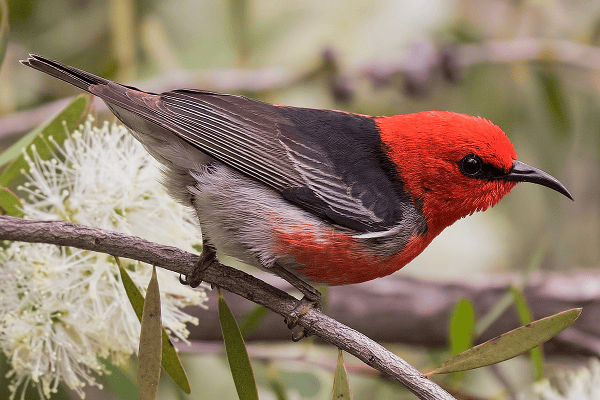
The Scarlet Honeyeater (Myzomela sanguinolenta) is a small bird found in Australia and Indonesia. Males exhibit bright red plumage, contrasting with their black upperparts.
Feeding Habits
Scarlet Honeyeaters primarily feed on nectar from various flowering plants. Their long, curved bills are adapted for accessing the sweet liquid inside flowers.
Floral Relationships
These honeyeaters contribute to pollination, forming mutualistic relationships with the plants they feed on. This symbiotic interaction benefits both the birds and the plants.
20. Red-Crowned Crane
In the list of birds with red heads we also have The Red-Crowned Crane (Grus japonensis) is a majestic bird native to East Asia. While its red crown is visible, its white plumage and graceful demeanor make it an iconic symbol.

Cultural Significance
In Japanese culture, the Red-Crowned Crane, known as the “tancho,” is a symbol of longevity, happiness, and good fortune. It holds a special place in art, literature, and folklore.
Conservation Efforts
Red-crowned cranes are classified as an endangered species due to habitat loss and human activities. Conservation programs aim to protect their breeding and wintering grounds.
21. Red-Headed Finch

The Red-Headed Finch (Amadina erythrocephala) is a charming finch species native to Africa. The male sports a vibrant red head, while the female’s head is gray-brown. With its colorful appearance and unique behaviors, this finch adds a touch of vibrancy to its habitat.
Breeding and Nesting
Male Red-Headed Finches engage in elaborate courtship displays to attract females. These displays may include puffing up their feathers, hopping around the female, and singing melodious songs. Once a pair forms, they work together to build intricate nests using twigs, grass, and feathers. These nests are well-hidden and carefully constructed to provide a safe environment for their eggs.
Social Behavior
Red-headed finches are highly social birds, often seen in flocks. Their interactions within these flocks are lively and dynamic, with frequent chirping and fluttering. These flocks not only protect from predators but also offer companionship and the opportunity to share information about food sources and potential dangers.
Diet and Foraging
The diet of Red-Headed Finches primarily consists of a variety of seeds, including grass seeds and those from various plants. They are also known to forage for insects, especially during the breeding season when they need to provide sufficient protein for their growing chicks. Their ability to switch between seeds and insects based on availability showcases their adaptability and resourcefulness.
Vocalizations and Communication
Red-Headed Finches are not particularly known for their melodious songs; however, they do emit a series of chirps and calls that serve as communication signals within their flocks. These calls help them coordinate movements, warn others of potential dangers, and establish their presence in the group hierarchy.
Conservation Status
As of now, the Red-Headed Finch does not face significant conservation threats. Its adaptability to various environments, including human-altered landscapes, has contributed to its stable population. However, as with many bird species, maintaining a balance between natural habitats and urban areas is crucial to ensure their long-term survival.
Frequently Asked Questions
Q1: What is a bird with a red head called?
A bird with a red head is often referred to as having a “red-headed” plumage.
Q2: What bird has a red cap?
A bird with a red cap is commonly known as having a “red-capped” appearance. Specific examples include the Red-capped Robin or the Red-capped Cardinal.
Q3: What kind of bird has a red patch on its head?
A bird with a red patch on its head may be described as having a “red-patched” head. Various species exhibit this feature, such as the Northern Cardinal or the Red-headed Woodpecker.
Q4: What bird has red on the forehead?
A bird with red on its forehead might be identified as having a “red-foreheaded” characteristic. Examples include the Red-fronted Parakeet or the Red-fronted Serin.
